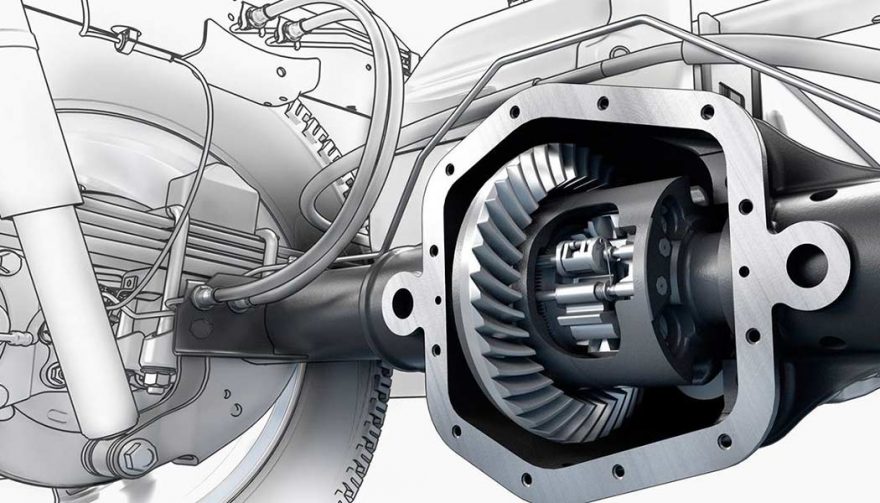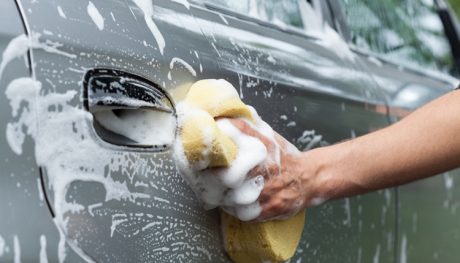
Don't think about keeping your clothes after changing the fluid in your differential
It’s Messy and Overlooked, But Differential Care Is Crucial
Relax, the word differential has nothing to do with calculus. At least not when it comes to car maintenance. But the expensive bill from your mechanic may seem like calculus if you don’t perform a differential fluid change.
Here’s some info on how our car differentials work and some tips for doing a differential fluid change.
What Is the Differential?
Gears, several types of gears and bearings, those are the types of expensive parts that make up the differential in a car. You might have heard the differential referred to as the car’s rear axle, but that is not correct nomenclature.
The differential assembly is just one component of the vehicle’s rear axle assembly. That’s a more precise description.
On front wheel drive cars, the differential is inside the transmission, usually called a transaxle. But it’s still there, because it is a vital link in the chain of parts that transmit power from the engine to the wheels.
Why Do Cars Have Differentials?
When you steer the car left or right, the wheels on opposite sides of the car roll at different speeds. If you steer right the car follows a turning radius and forces the outside wheels, the left ones, to speed up. They are following a larger turning radius than the right-side wheels are. See the picture?
The differential is the coupling that allows the drive wheels on opposite sides of the vehicle to turn at different speeds as you steer the vehicle.
Different Types of Differentials
The most common is the open differential. It has the fewest components, and works perfectly well on dry pavement. It will transmit power equally to each drive wheel under normal conditions.
But when you encounter slippery road conditions, the open differential will transmit power to the wheel with the least traction. That’s why you will see a car that is stuck in mud spinning one rear wheel furiously, while the other wheel that is on good dry pavement is doing nothing to help. Not fair, is it?
To solve that problem, engineers have designed some types of differentials to split the power more evenly when conditions require. Some only allow limited slippage between the wheels and others induce a complete lock up between them.
The important thing to know, however, with any type of traction-enhancing differential is that they require a special type of differential fluid. They wrong type will cause their slipping clutches to burn out very rapidly.
The more common malady, though, is when the wrong type of fluid causes the clutch plates inside the differential to stick together when the car is started on cold mornings.
You will hear the rear tires “chirping” as they strive to turn at different speeds while the plates resist their free movement. Enough said about that.
Types of Differential Fluids
Cars of the ’70s and earlier used very heavy gear fluid in their differentials, typically 90-weight and heavier. Heavy fluid robs power and reduces fuel economy. It takes power to make gears spin in molasses-thick fluid.
Newer vehicles use very thin fluid, usually synthetic in composition, to reduce that power loss. And for that chirping noise we mentioned? To prevent that, some vehicles require a special additive to the differential fluid.
Just take the easy way out and read your owner’s manual to learn the exact type and amount of fluid your car needs.
Performing a Differential Fluid Change
First thing first, you need to be sure you prevent the car from rolling. You are going to jack up the rear of the vehicle to drain the differential fluid. What keeps the car from rolling when it is parked? The lock mechanism inside the automatic transmission locks the rear wheels. Raise them from the ground, though, and there is nothing to prevent the car from rolling away on you.
What about the parking brake? It only works on the rear wheels, so applying it won’t help you either.
Make sure you are working on a flat, level surface. And you have to use wheel chocks. If you don’t have a set, get them at an auto parts store or online. Don’t use bricks or pieces of lumber to protect your life.
How to Remove the Old Differential Fluid
Bear in mind when you’re doing a differential fluid change, it’s not like an engine. Rear axles normally don’t have drain plugs, as nice as that would be. You have to remove the sheet metal inspection cover, the part with all the bolts around it like numbers on a clock, to drain the fluid.
Then scrape the old gasket, or silicone gasket material, away from the axle housing and from the inspection cover, clean them thoroughly and get them very dry, then reassemble with a new gasket or a tube of silicone sealer.
Yep, it’s a little bit of work, and it’s awkward because you can never get the car high enough off the ground to be comfortable working under it. Sorry.
As an alternative to removing the inspection cover, you could get an inexpensive suction gun from the auto parts store. It will be obvious how it works when you see one, but you (in theory) can suck the old fluid out of the axle, through the fill plug opening, with the suction gun.
But you won’t get all the old fluid out like that. And beware. It is a very messy process. The guns always leak, and badly at that. That’s why they are so inexpensive. Nobody in their right mind would spend very much money on such a cheap contraption.
Putting in New Differential Fluid
But don’t throw away that lousy, cheap, leaky suction gun from the last paragraph. You’re going to use it now.
The bottles of new differential fluid have nozzles on them, which leads you to believe you just cut the end off and squirt the new fluid in. That is just to taunt you, though. There is never enough room under the car to get the fluid bottles inverted enough to squeeze all the fluid out of them.
Sometimes you can place a short piece of rubber hose on the nozzle of the fluid bottle and try that. Typically, you will spill half the new fluid on the ground when the hose pops off under pressure. Buy a bottle or two more than you think your car needs.
Get Rid of Your Clothes
Burned, old, worn-out differential fluid has a very distinct odor. It stinks. The odor will permeate your clothes, and your spouse will not let you back inside the house wearing them.
Don’t even think of putting the stinky clothing inside the washing machine, not even on the heavy-duty cycle. The smell will remain in the machine, and everything you wash for a few more cycles after that will come out with the odor of automotive gear grease on it.
So plan to wear your oldest work clothes when you perform a different fluid change, and to throw them away when you are done.





